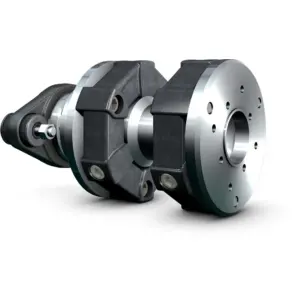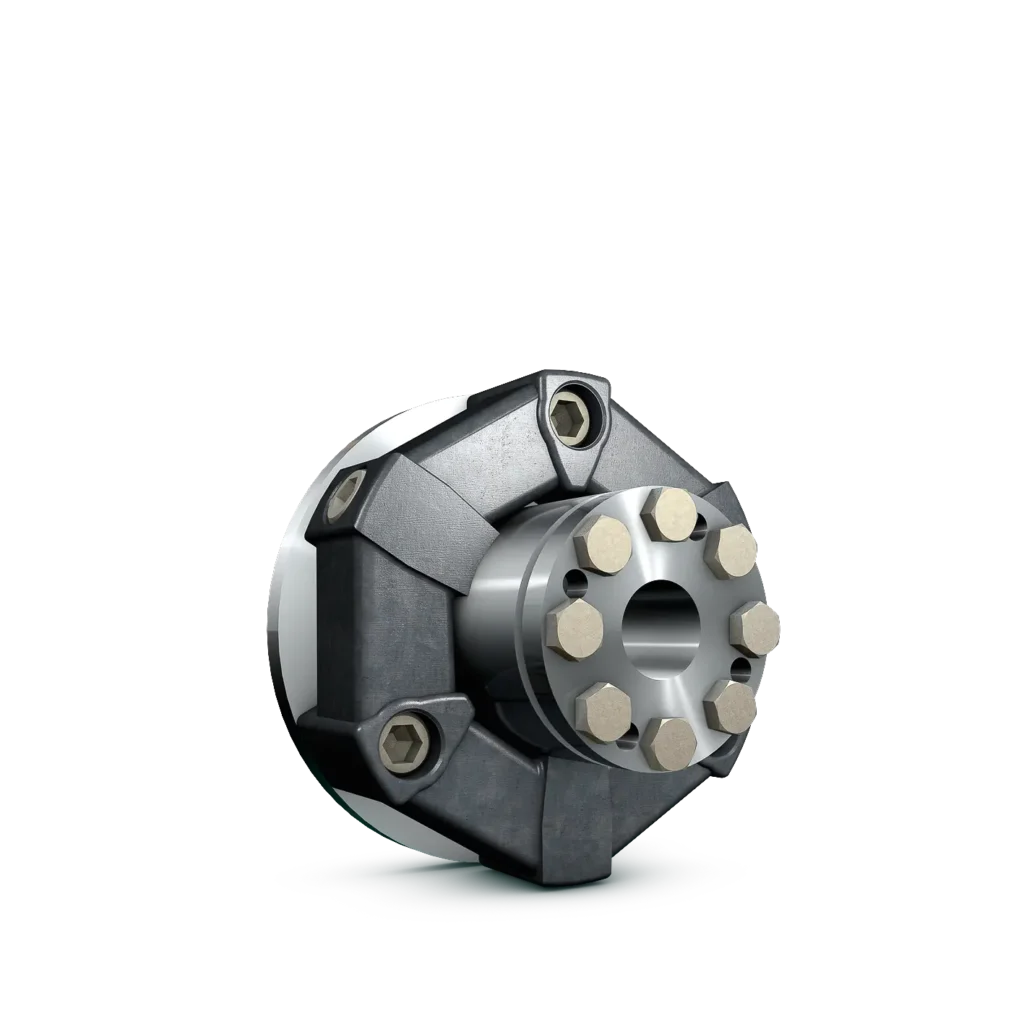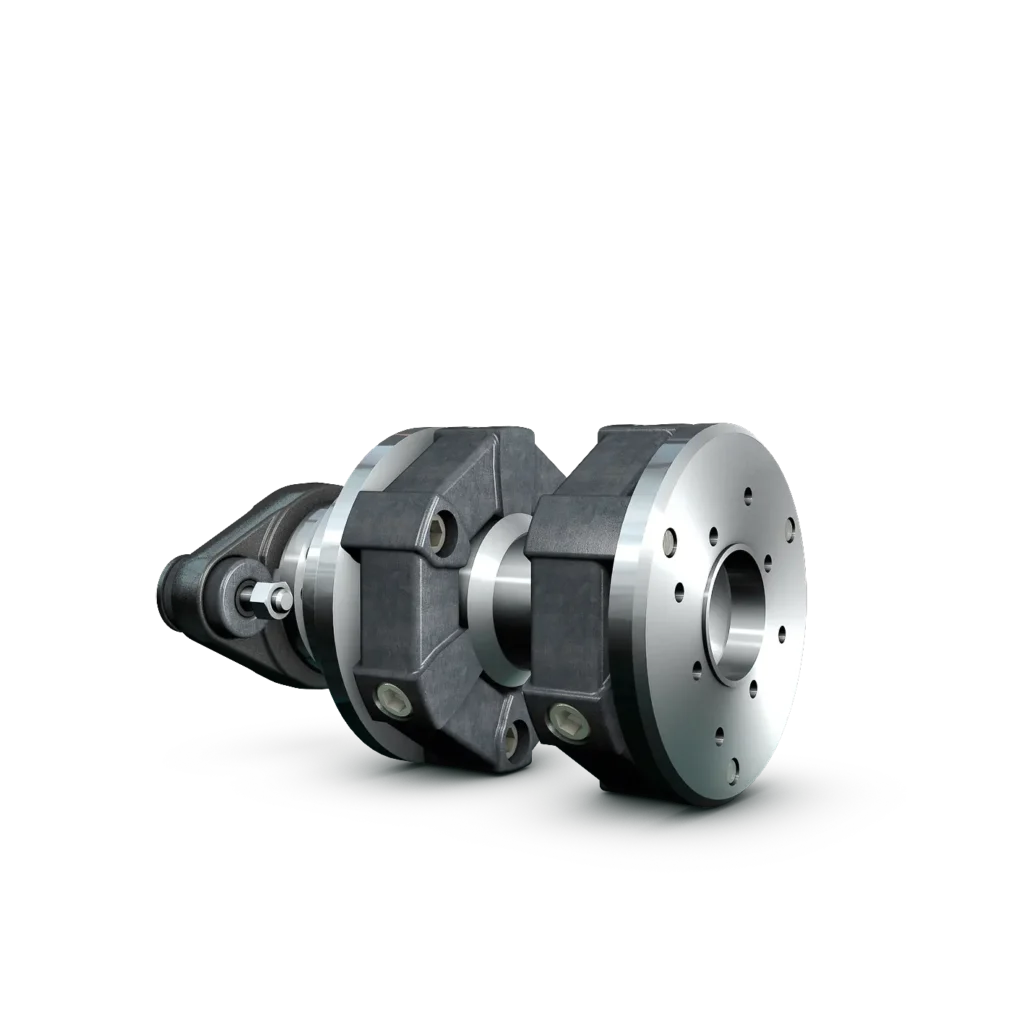Thrust bearing
Together with the technical joint, bearings are among the guiding elements in machine and device construction. The bearings enable movements in desired degrees of freedom. They also restrict movement in undesirable degrees of freedom. A distinction is made between different bearing types according to these degrees of freedom.
One of these is the thrust bearing, which is also commonly referred to as a thrust bearing, track bearing or longitudinal bearing. This article reveals what a thrust bearing does and why we, as specialists in drive technology and Couplings of all kinds, deal with thrust bearings every day.

The function and definition of the thrust bearing
Thrust bearings prevent axial movements in a shaft and withstand forces in the direction of the shaft. The thrust bearing bears its name because only compressive forces can be transmitted between the two plain bearing parts. In contrast to a radial bearing, the contact angle of an axial bearing is increased to 90 degrees, which means that only axial loads are generated, i.e. forces in the direction of the axle or shaft. The load is then distributed evenly across all rolling elements of the component.
Thrust bearings can be rolling bearings or plain bearings and are often used in combination with radial bearings.
Different types of thrust bearing
Thrust bearings are found as classic axial bearings, but also as special designs such as swivel bearings, slewing rings and axial angular contact ball bearings. Typical designs are
AXIAL DEEP GROOVE BALL BEARING
AXIAL CYLINDRICAL ROLLER BEARINGS
AXIAL NEEDLE ROLLER BEARING
AXIAL SPHERICAL ROLLER BEARINGS AND
AXIAL TAPERED ROLLER BEARING
Areas of application for thrust bearings
Thrust bearings, also known as axial bearings, are suitable for low speeds with low centrifugal forces and very high rigidity. They are mainly found in boat and shipbuilding, in large machines and cranes, large agricultural machines and vehicles such as combine harvesters and in the field of energy supply, for example in wind power technology or stationary power generators.
Thrust bearing in the navy
Thrust bearings are indispensable in the maritime sector, in boat and shipbuilding. They ensure whisper-quiet running in cardan shafts. In shipbuilding, they are designed for very high axial forces and can also absorb radial loads.
Examples of high-performance thrust bearings in the navy
Particularly in the marine sector, hard-wearing and high-performance thrust bearings are indispensable. CENTA is the specialist for marine couplings of all kinds. The highly flexible couplings ensure a whisper-quiet boat thanks to backlash-free torque transmission, while the highly flexible CENTAFLEX PTO shaft couplings of the AGM and ACV designs offer the highest level of comfort.
CENTAFLEX AGM and CENTAFLEX ACV – similarities and differences
Both the CENTAFLEX AGM and the CENTAFLEX ACV are equipped with a self-aligning thrust bearing and an elastically bolted flange. The axial loads are thus transferred to the boat’s hull, the boat’s engine is free of propeller forces and is mounted elastically. The result of this shaft Coupling is much less noise and vibration, and it also dampens torsional vibrations and shocks. Structure-borne noise is also prevented. The highly flexible CENTAFLEX AGM and CENTAFLEX ACV couplings have proven themselves for many years as high-quality, damping drive systems on various types of ships and boats. They were specially developed for use as a connection between the reversing gear and propeller shaft in yachts and boats.
The CENTAFLEX AGM is suitable for connections with moderate angular deviations of around 1 degree. The angles for the CENTAFLEX element and those for the VC joint should be as small as possible to ensure the longest possible trouble-free operating time. However, it is important that the angle for the CV joint is at least 1 degree, only then is the lubrication of the ball guaranteed.
The CENTAFLEX ACV is ideal for use with large angular deviations of around 3 and up to 8 degrees.


The advantages of a CENTAFLEX Coupling at a glance
BACKLASH-FREE, TORSIONALLY FLEXIBLE CONNECTION FOR DAMPING TORSIONAL VIBRATIONS OF THE MOTOR
NOISE INSULATION UP TO DBA AND MORE
REDUCED VIBRATIONS PROTECT THE FIXTURES, ESPECIALLY ELECTRICAL EQUIPMENT
COMPENSATION OF ALL TYPES OF DISPLACEMENTS, RESULTING IN LESS WEAR AND TEAR
DIRECT TRANSMISSION OF THE PROPELLER THRUST FROM THE SHIP’S SHAFT DIRECTLY TO THE HULL
SIMPLE FASTENING WITH CLAMPING HUB
NO TIME-CONSUMING ASSEMBLY DUE TO PRE-MACHINING OF FLANGE CONNECTION AND HUB
PROTECTION AGAINST ELECTROLYSIS DAMAGE THROUGH ELECTRICAL INSULATION
The use of thrust bearings in agriculture
In agriculture, too, thrust bearings ensure stability and smooth running for both large and small agricultural machines. In vehicle construction, it is a component in the Coupling that creates a connection between the clutch pressure plate, which rotates, and the fixed release mechanism. This is why they are also called release bearings. Thrust bearings in vehicles ensure smooth starting and stopping.
Thrust bearings in the industry
Thrust bearings are also used in industry, particularly in mechanical engineering and plant construction, where highly flexible couplings in modern machinery and plant ensure that production runs smoothly and comparatively quietly.
Energy supply: The use of thrust bearings
Companies in the energy supply sector and operators of energy supply systems also rely on optimally functioning, modern, safety-tested thrust bearings in their drive systems. Wind turbines, natural gas supply systems, CHP units and much more would not function without a thrust bearing that is designed to withstand the high demands and forces involved.
Maintenance and care
Friction occurs wherever thrust bearings and all other types of bearings are used. Highly flexible couplings with modern thrust bearings already reduce this to a large extent, but friction cannot be completely eliminated. It is therefore necessary to maintain and clean them regularly. Dirt residue, swarf and similar material can build up and lead to loss of performance, excessive wear and premature end of life of the Coupling or thrust bearing. Regular cleaning and an automatic lubricant supply can prevent this.
In addition, we can assist you not only with the purchase of thrust bearings, but also with maintenance and repairs. Clutch reconditioning, tool supply, TVC/clutch design, alignment check, cardan shaft overhaul or spare parts supply for your drive technology? PMP is there for you!
Talk to us, we look forward to hearing from you.



